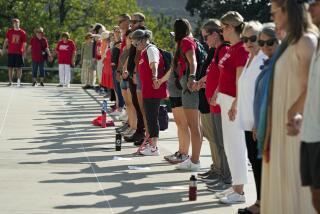Stricter Control Urged in Tobacco Availability
- Share via
Researchers who sent an 11-year-old girl into 100 stores to buy cigarettes to dramatize the ease with which children can get tobacco have called for enactment of model state laws to control tobacco use among minors--and significantly better enforcement of existing laws.
The project, undertaken by researchers at the University of Massachusetts, involved cigarette purchases made by a sixth-grade schoolgirl. She was successful in her attempts in 75 of the 100 Massachusetts stores she visited under supervision of project investigators.
Report Published
A report of the research study was published in the June 26 Journal of the American Medical Assn. The researchers, led by Dr. Joseph DiFranza, noted that 10 states don’t legally bar children from buying smoking materials and that, of the 40 states that do have laws of some sort, most don’t enforce their statutes effectively.
Only two states, DiFranza said in a telephone interview, have anything approaching effective programs--Oklahoma and South Carolina. California authorities, he said, have never made an arrest under laws here that bar sales to anyone under 18.
The DiFranza team urged enactment of new state laws that would: outlaw possession of tobacco by children completely, a stricture now in effect in only 12 states; prohibit tobacco use on school grounds; prohibit tobacco sales to people under 21; require school courses in the health hazards of tobacco; outlaw cigarette vending machines and reward informers who turn in anyone selling tobacco to minors. Enforcement of the laws would be significantly strengthened.
“We need to put some teeth in state tobacco laws and make them enforceable,” DiFranza said. The research report concluded: “Given that only 10% of current smokers began as an adult, enforcement of minors’ tobacco-access laws presents a unique opportunity to deal a mortal blow to this fatal addiction.”
Studies About Speed
Contradicting the rationale behind recent changes in speed limits that permit a 65 m.p.h. maximum on nonurban superhighways, two motor vehicle crash studies have found that isolated rural roadways have the most dismal injury and fatality rates.
According to one research team, whose findings were reported last week, rural counties outstrip large, populous areas in terms of motor-vehicle death toll by factors of several hundred-to-one. Esmeralda County in Nevada, for instance, had the equivalent death rate of 558 people killed per 100,000 population while Loving County, Tex., had an equivalent rate of 1,456.
This contrasted with New York City (2.5 deaths per 100,000) and Philadelphia (4.1). The study, published last week in the New England Journal of Medicine, was conducted by the Johns Hopkins School of Hygiene and Public Health and the Insurance Institute for Highway Safety. It came several weeks after a Metropolitan Life Insurance Co. evaluation of regional motor vehicle fatality differences found the safest regions of the country to be the South-Central and Mid-Atlantic states and the most dangerous the Mountain and West South-Central states.
The highest annual death rates for motor vehicle crashes were recorded, Metropolitan Life found, in New Mexico (80.8 deaths per 100,000 for all age groups), Wyoming (85.9), Arizona (60.6), Montana (61.2) and Nevada (66). Statewide in Wyoming, more than 134 of every 100,000 young men 15 to 24 died in car crashes. California’s rate was 51.1 for all men. Rhode Island had the lowest rate--25.7.
While small populations and possibly poor local conditions on rural streets and highways might explain some of the difference, both of the new studies found remarkable consistency among comparatively unpopulated counties and states. The Johns Hopkins study was the first ever to look at fatalities on a county-by-county basis.
“Ironically, the current impetus for raising the 55-m.p.h. speed limit comes primarily from states in the West,” the Johns Hopkins team concluded, “where fatality rates on rural interstate highways are more than twice the national rate.” Observed Metropolitan Life researchers: “The high social and financial costs to society from motor vehicle accidents demand even more stringent public programs to curb this preventable form of suffering.”
Lefties and Preemies
Extremely premature babies weighing a pound or less at birth--whose survival is becoming increasingly common--have been found to have at least one quirk that will remain with them all of their lives: At least one study found they were left-handed more than half the time.
It’s too early to determine if this oddity among premature births--the overall rate of left-handedness is 8% to 10%--will influence the caliber of major-league pitching. But a team of doctors in Australia and Boston has found that in a study group of 115 babies treated in a neonatal intensive care unit, 54% of extreme preemies were left-handed.
Two theories have been advanced to explain the distinction: left-handedness is caused by slight brain damage sustained during the extremely early birth or that very premature infants do not complete a process of brain development that results in the vast majority of full-term infants being right-handed. In the journal Lancet, the researchers, from Brigham and Women’s Hospital in Boston and the University of Queensland in Australia, speculated that shortened brain development is the most likely cause.
More to Read
Sign up for Essential California
The most important California stories and recommendations in your inbox every morning.
You may occasionally receive promotional content from the Los Angeles Times.












